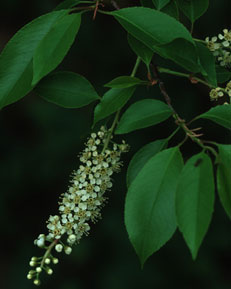 |
Black Cherry
Prunus serotina
Family: Rosaceae
CTFA name: Wild Cherry (Prunus Serotina) Bark Extract |
Return to herb list |

Photo © Steven Foster
Introduction
Native to North America,1 black cherry currently grows from Nova Scotia to Florida, westward to Texas, north through Oklahoma, and eastern portions of Kansas, Nebraska, and South Dakota.2 Growing to 80 feet,3 the tree has shiny leaves that turn yellow or red in autumn, fragrant white flowers that bloom in late spring and early summer,1 and purplish-black fruit in August and September.3 The bark and fruits of the cherry tree are collected in the fall.4 History and Cultural Significance
From ancient times to modern, the cherry has been associated with virginity.5 Some believe that the red colored fruit with its enclosed seed symbolizes the uterus. It is traditionally believed that the virgin mother of Buddha, Maya, was offered fruit and support while pregnant by the holy cherry tree. In Danish folklore, the first ripe fruit was to be eaten by a woman shortly after her first child was born to insure a good crop of cherries.5 Historically, black cherry bark was used in the treatment of tuberculosis, indigestion, and in various types of bronchitis and coughs.3 In the form of an infusion (made by boiling the bark rather than steeping as in tea), it was used to treat diarrhea and pain.4 Black cherry bark was also thought to have astringent (drying) and sedative properties.4 Various Native American tribes employed black cherry bark for the uses mentioned above, as well as for colds, fevers and chills, measles, thrush, laryngitis, worms, burns, and as a blood purifier.6 Modern Research
Currently there are no clinical studies available on the internal or external use of black cherry. Future Outlook
No information is available on the market statistics of black cherry. It remains to be seen if the market warrants its commercial cultivation. References
1 Bown D. The Herb Society of America New Encyclopedia of Herbs and Their Uses. London: Dorling Kindersley Ltd.; 2001. 2 Black Cherry. 1998. Available at: http://www.hort.purdue.edu/newcrop/herbhunters/blackcherry.html. Accessed March 16, 2005. 3 Grieve M. A Modern Herbal. Vol I. New York: Dover Publications;1971. 4 Leung AY, Foster S. Encyclopedia of Common Natural Ingredients Used in Food, Drugs, and Cosmetics. 2nd ed. New York: John Wiley & Sons, Inc.; 1996. 5 Cherries-Prunus avium, Prunus cerasus. 2005. Available at: http://www.uga.edu/fruit/cherry.htm. Accessed March 16, 2005. 6 Moerman DE. Native American Ethnobotany. Portland, OR: Timber Press; 1998.
|